I want to control a motor's direction electrically. When the input is a zero, I want it to go one way, and a 1, the other way. The only way I can think of this is a solenoid with a spring attached to a DPDT reverse switch wired to the motor, so when theres current, the switch moves one way, and none it goes to it's original position. This is very inefficient and bulky, so is there a way to control the direction electrically? I prefer transistors and common electronic parts, but if I have to get a chip or something, it'l do.
Asked
Active
Viewed 282 times
2
-
1H-bridge (of fullbridge) is the name of the part you are looking for. You can build such things out of 4 MOSFETs – angelatlarge Apr 07 '13 at 21:07
-
1I agree with @angelatlarge but what motor voltage and current are you expecting. The circuit you are describing is called a relay. Most have DPDT capability so you can do a reverse change when you drive the coil - it isolates the control circuit from the motor too so it works on ac power line stuff. – Andy aka Apr 07 '13 at 21:13
-
I don't know the exact current, but 9-12 volts and probably less then a half an amp, so the MOSFET stuff should be good for it – skyler Apr 07 '13 at 21:15
-
Can an H-bridge be made out of p-channel MOSfets? – skyler Apr 07 '13 at 21:16
-
Yes, but you wouldn't want to. Conceptually simple is P channel on the high side and N channel on the low, though N channel devices work enough better that designers often jump through the hoops necessary to use them on the high side too. Inverting those tricks to use P channel on both would be possible, but not advantageous. – Chris Stratton Apr 07 '13 at 21:17
-
its just I have 20 p-channel power Mosfets (irf9540) and I am running low on n channel so I would like to if I could – skyler Apr 07 '13 at 21:29
-
Go with the relay : simple and robust. And probably smaller than you expect. – Apr 07 '13 at 21:36
-
Then I'll have to have a relay, and my Mosfets for the PWM part – skyler Apr 07 '13 at 21:49
-
The only issue with a relay is that they don't last forever: the contacts have a lifetime. MOSFETs (when done right) do last essentially forever. One advantage of making an H-bridge out of discrete components is higher possible current load (due to better heat dissipation) – angelatlarge Apr 07 '13 at 22:16
1 Answers
1
You want to use an H-bridge, which is nothing more than four electronic switches hooked up in a nifty way that lets you change the direction of current through a motor. THIS is a pretty nice review.
 From http://www.mcmanis.com/chuck/robotics/tutorial/h-bridge/
From http://www.mcmanis.com/chuck/robotics/tutorial/h-bridge/
Don't try to build one- buy one like the SN754410. You need to be a little careful if you see "half bridge". Two half bridges are used to make a full H-bridge. That chip has four half bridges.
Scott Seidman
- 29,274
- 4
- 44
- 109